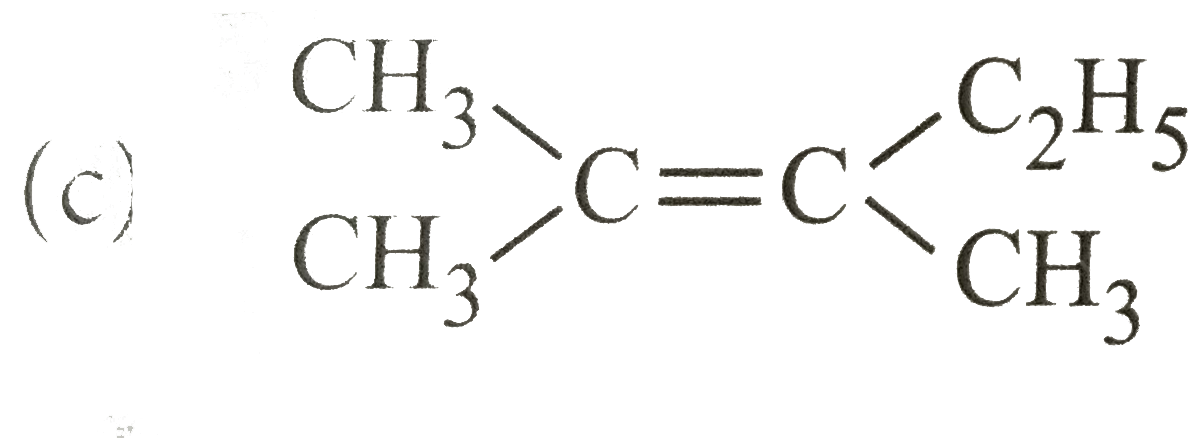An unsaturated hydrocarbon was treated with ozone and resulting ozonide on hydrolysis gives 2-pentanone and acetaldehyde. What is the structure of alkene?
C3H7−CH=CH−CH3



The correct Answer is:B
To determine the structure of the unsaturated hydrocarbon (alkene) that, upon ozonolysis, yields 2-pentanone and acetaldehyde, we can follow these steps:
Step 1: Understand the Products
The products of ozonolysis are given as 2-pentanone and acetaldehyde.
- 2-pentanone has the structure:
CH3−CO−CH2−CH2−CH3
- Acetaldehyde has the structure:
CH3−CHO
Step 2: Analyze the Ozonolysis Reaction
In ozonolysis, the alkene reacts with ozone to form an ozonide, which upon hydrolysis breaks down into carbonyl compounds (aldehydes or ketones). The reaction can be summarized as:
Alkene+O3→Ozonide→Aldehydes/Ketones
Step 3: Determine the Alkene Structure
To find the alkene that produces these specific carbonyl compounds, we can deduce the structure based on the products:
- The carbon skeleton of 2-pentanone suggests that one of the carbonyl groups comes from a ketone formed by breaking the double bond in the alkene.
- The presence of acetaldehyde suggests that the other carbonyl group comes from an aldehyde.
Step 4: Construct Possible Alkene Structures
Given that we need an alkene that can yield both products:
- The carbon chain must be long enough to accommodate both products.
- The double bond must be positioned such that upon ozonolysis, it can yield both 2-pentanone and acetaldehyde.
Let’s consider the alkene 3-hexene:
CH3−CH2−CH=CH−CH2−CH3
Step 5: Perform Ozonolysis on 3-Hexene
When 3-hexene undergoes ozonolysis, the double bond breaks and forms:
- One part leads to 2-pentanone:
CH3−CO−CH2−CH2−CH3
- The other part leads to acetaldehyde:
CH3−CHO
Conclusion
Thus, the structure of the unsaturated hydrocarbon (alkene) is 3-hexene.
The products of ozonolysis are given as 2-pentanone and acetaldehyde.
- 2-pentanone has the structure:
CH3−CO−CH2−CH2−CH3
- Acetaldehyde has the structure:
CH3−CHO
In ozonolysis, the alkene reacts with ozone to form an ozonide, which upon hydrolysis breaks down into carbonyl compounds (aldehydes or ketones). The reaction can be summarized as:
Alkene+O3→Ozonide→Aldehydes/Ketones
To find the alkene that produces these specific carbonyl compounds, we can deduce the structure based on the products:
- The carbon skeleton of 2-pentanone suggests that one of the carbonyl groups comes from a ketone formed by breaking the double bond in the alkene.
- The presence of acetaldehyde suggests that the other carbonyl group comes from an aldehyde.
Given that we need an alkene that can yield both products:
- The carbon chain must be long enough to accommodate both products.
- The double bond must be positioned such that upon ozonolysis, it can yield both 2-pentanone and acetaldehyde.
CH3−CH2−CH=CH−CH2−CH3
When 3-hexene undergoes ozonolysis, the double bond breaks and forms:
- One part leads to 2-pentanone:
CH3−CO−CH2−CH2−CH3
- The other part leads to acetaldehyde:
CH3−CHO
Thus, the structure of the unsaturated hydrocarbon (alkene) is 3-hexene.
Topper's Solved these Questions
- BOOK - NCERT FINGERTPS ENGLISHCHAPTER - HYDROCARBONS EXERCISE - Higher Order Thinkin Skills7videos
HYDROCARBONS
- BOOK - NCERT FINGERTPS ENGLISHCHAPTER - HYDROCARBONS EXERCISE - Assertion & Reason15videos
HYDROCARBONS
- BOOK - NCERT FINGERTPS ENGLISHCHAPTER - EQUILIBRIUM EXERCISE - Assertion And Reason15videos
EQUILIBRIUM
- BOOK - NCERT FINGERTPS ENGLISHCHAPTER - HYDROGEN EXERCISE - Assertion And Reason15videos
HYDROGEN
Similar Questions
An olefin was treated with ozone and the resulting ozonide on hydrolysis gave 2-pentanone and acetaldehyde. Write equations for the reaction involved.
View SolutionA hydrocarbon decolourised bromine water. On ozonolysis it gives 3-methyl butanal and acetaldehyde. Write the structure of the hydrocarbon.
View SolutionThe reductive ozonolysis of an alkene gives a mixture of acetone and formaldehyde. What is the structural formula of the alkene?
View SolutionAn unsaturated hydrocarbon 'A' adds two molecules of H2 and on reductive ozonolysis gives butane-1, 4-dial, ethanal and propanone. Give the structure of 'A' , write its IUPAC name and explain the reactions involved.
View SolutionWhat happens when benzene is treated with ozone and the product is subjected to hydrolysis
View SolutionA compound (A) reacts with thionylchloride to give a compound (B). (B) reacts with magnesium to form a Grignard reagent which is treated with acetone and the product is hydrolysed to give 2-methyl butan-2-ol. What are the structural formulae of (A) and (B) ?
View Solution1-Ethyl-2-methyl oxirane when treated with C2H5MgBr, followed by hydrolysis gives :
View SolutionCompound (X) C6H5O gives yellow coloured ppt with 2,4 DNP but does not give red colored ppt with Fehiling's solution (X) on treatement with NH2OHH+ gives compound (Y) C6H5NO (Y) when treated with PCl5 gives isomeric compound (Z) . (Z) on hydrolysis gives propanoic acid and aniline. what will be the correct structure of (X) ,(Y) and (Z) ?
 View Solution
View SolutionAn unsaturated hydrocarbon on complete hydrogenation gives 1-isopropl-3-methylcyclohexane, after ozonolysis it gives one mole of formaldehyde, one mole of acetone and one mole of 2,4-Dixoxohexanedial.The possible structure of the hydrocarbon may be
View Solutiona. Give the structure of lowest molecular mass and optically active alkyne.
b. Give the structure of unsaturated hydrocarbon with lowest molecular mass showing diastereomers.
c. Give the structure of alkyne that gives the same product on reaction with either H2+Ni2B or K+C2H5OH.
d. Give the structure of alkyne that gives the same single product on reaction with either (B2H6/THF+H2O2/ӨH) or dil. H2SO4/Hg2+/H⊕.
e. Give the structure of alkyne that gives the same two products with either of the reagents in (d).View Solution
